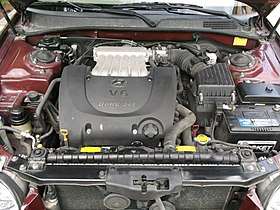Hyundai Delta engine
The Hyundai Delta family is the company's smaller V6 engine, ranging from 2.5 to 2.7 L (2,493 to 2,656 cc). Both share the same 75 mm (2.95 in) stroke and both are DOHC designs.
Δ-engine Delta engine | |
|---|---|
 | |
| Overview | |
| Manufacturer | Hyundai Motor Company |
| Layout | |
| Configuration | V6 |
| Displacement | 2.5 L; 152.1 cu in (2,493 cc) 2.7 L; 162.1 cu in (2,656 cc) |
| Cylinder bore | 84 mm (3.31 in) 86.7 mm (3.41 in) |
| Piston stroke | 75 mm (2.95 in) |
| Block material | Aluminum |
| Head material | Aluminum |
| Valvetrain | DOHC 4 valves x cyl. |
| RPM range | |
| Idle | 700±100 |
| Combustion | |
| Fuel system | Multi-port fuel injection |
| Fuel type | Gasoline |
| Cooling system | Water-cooled |
| Output | |
| Power output | 167–174 PS (165–172 hp; 123–128 kW) |
| Torque output | 23.5–25 kg⋅m (230–245 N⋅m; 170–181 lb⋅ft) |
| Chronology | |
| Successor | Mu |
2.5 litre
The G6BW/G6BVV (also called the 2.5 D) is the 2.5 L; 152.1 cu in (2,493 cc) version in a 90˚ configuration with an 84 mm (3.31 in) bore. Output is 172 PS (170 hp; 127 kW) at 6000 rpm and 23.5 kg⋅m (230 N⋅m; 170 lb⋅ft) at 3750 rpm. It made its first appearance in the 1999 EF series Sonata.
2.7 litre
The G6BA/G6BAX/G6BAY (also called the 2.7 D) is the larger 2.7 L; 162.1 cu in (2,656 cc) version available in either 60˚ or 90˚ configuration with an 86.7 mm (3.41 in) bore. Output is 167–180 PS (165–178 hp; 123–132 kW) at 6000 rpm and 25 kg⋅m (245 N⋅m; 181 lb⋅ft) of torque at 4000 rpm. It has an aluminum engine block and aluminum DOHC cylinder heads. It uses Multi-port fuel injection, has 4 valves per cylinder, and features powder metal-forged, fracture-split connecting rods.
Applications
- Hyundai Coupe (2001-2009)
- Hyundai Grandeur (1998-2005)
- Hyundai Santa Fe (2000-2006)
- Hyundai Sonata (1999-2005)
- Hyundai Tiburon (2003-2008)
- Hyundai Trajet
- Hyundai Tucson (2004-2009)
- Kia Opirus (2003-2006)
- Kia Optima (2000-2006)
- Kia Sportage
- Oullim Spirra